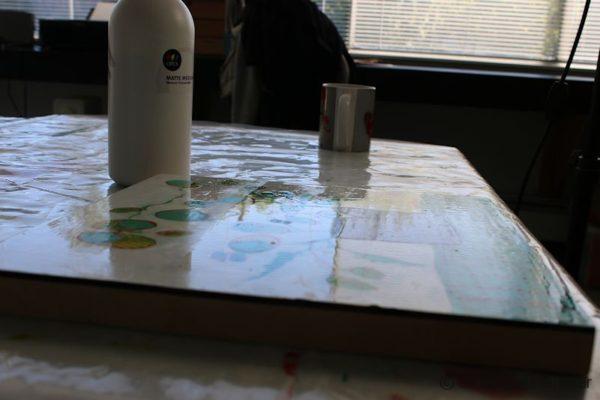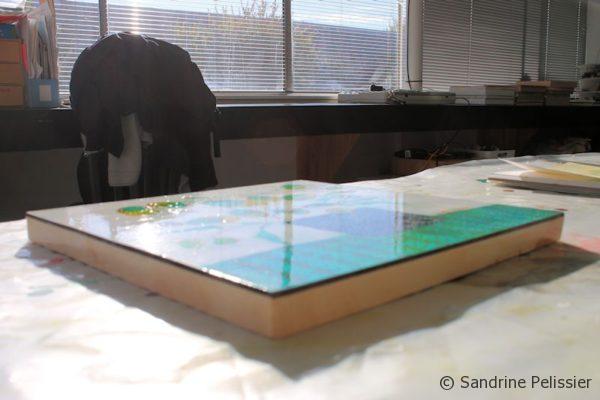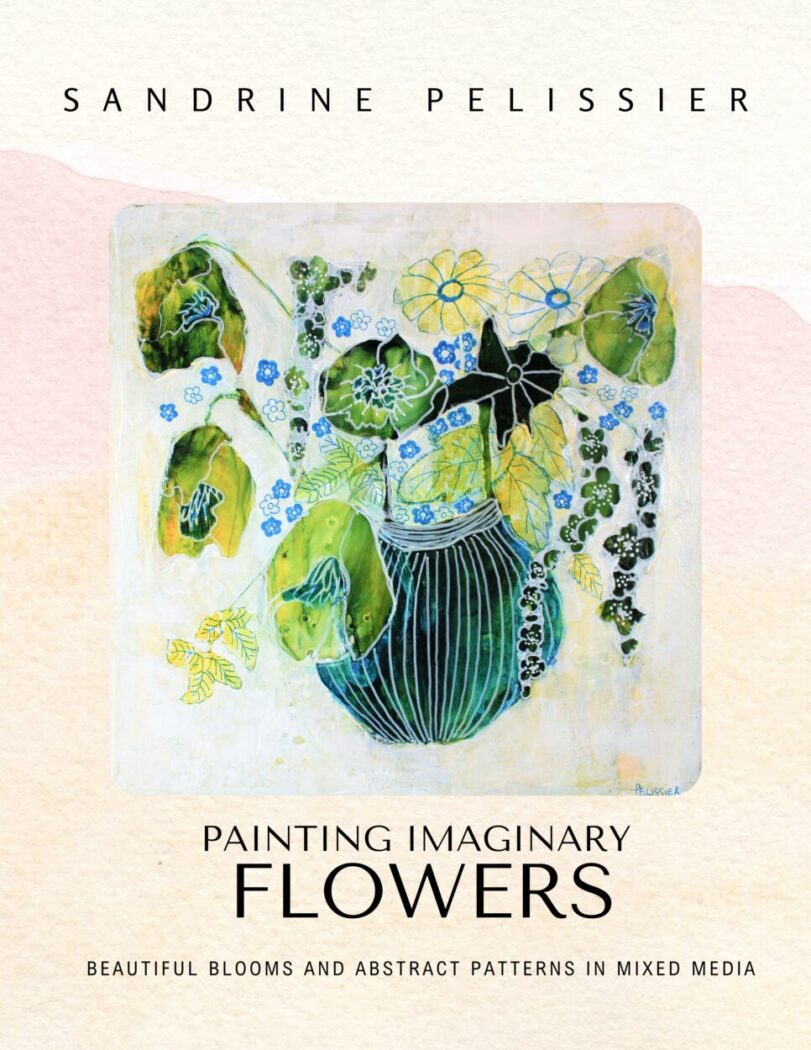How to apply an isolation coat to your paintings before varnishing
October 31, 2016 2022-02-22 10:28How to apply an isolation coat to your paintings before varnishing

How to apply an isolation coat to your paintings before varnishing
It is a good idea to apply an isolation coat on your paintings before varnishing.
Why?
- I like that some varnish are meant to be removable. It is a good thing because if you change your mind after a painting has been varnished, you can take off the varnish with mineral spirit. This would not work with acrylic based varnishes which are permanent. The risk when taking off the layer of varnish is to remove some of the paint as well. To avoid that, you can seal your painting with an isolation coat before applying the varnish.
- I am also sometimes a bit nervous about the way varnish can react with mixed media and want to make sure nothing is going to happen with the varnish or smudge when I apply it, an isolation coat will prevent that to happen.
You might also like: Mounting a watercolor painting on a cradled panel board, a step by step tutorial
Here is how to apply an isolation coat

Once your paint had enough time to dry thoroughly, I always recommend you apply a layer of spray fixative. You have to do it outside as you are not supposed to breathe that product. The fixative will fix any medium and prevent any smudging from happening.

In a container, pour a small quantity of acrylic medium.
I am a Blick Art Materials affiliate and I receive a small compensation for sales. That does not effect in any way the cost of the purchaser’s order but it helps me keeping the content of this blog free.

 |
Liquitex Acrylic MediumsGel mediums are ideal for extending a heavy body paint, to create impasto, relief, or sculptural effects. – Gel Medium, Gloss |

Add about the same quantity of water. Try to not go over 50% water as this is the ratio at which the acrylic starts loosing its binding properties.

Mix the water and the acrylic medium very well in your container. You will get a milky liquid that will dry transparent.

Apply this mix with a soft brush.

Try not to go over the same area twice, this is very important as it could make some of your acrylic or ink smudge. Try to go fast and in one go.

Look against the light to see if you missed any part.

At this point I like to let the painting dry overnight. Then you are ready to apply a layer of varnish. I recommend either Liquitex soluvar or Gamvar by Gamblin. Both are removable with mineral spirits and both are suitable for both oil or water-based media.
I am a Blick Art Materials affiliate and I receive a small compensation for sales. That does not effect in any way the cost of the purchaser’s order but it helps me keeping the content of this blog free.

 |
Gamblin Gamvar VarnishGamvar is a synthetic resin gloss varnish developed by conservators at the National Gallery. It can be used on acrylic paintings as well as oils. Gamvar is a synthetic resin varnish with a high refractive index similar to that of natural resins.
|

Again when varnishing you can look against the light to see if you missed any part. Let the varnish dry and you are done!
Acrylic and mixed media on Claybord
12 x 12 inches

















Comments (12)
ron
Can I use any acrylic medium or just gloss gel ??
Sandrine Pelissier
yes acrylic medium will work, gloss gel is just a specific type of medium.
jnine493475600
Okay, about this isolation coat…question….first a quick explanation. I’ve painted, with acrylics, river rocks at the bottom of river and now I am glazing quite a few layers blue, green, indian yellow, to give the appearance of under water. The original artist did it in oils. He suggests doing ISOLATION coats between glazes. Question #1 – Does it matter how many layers of glazing I do before negative affects occur? #2 – Your opinion on isolation coats between layers of glaze? Thank You so much Sandrine. Your fan, Jeanine
Sandrine Pelissier
Hello Jeanine.
I am not sure about isolation coats with acrylic on top of oils as you are not supposed to paint lean over fat.
In your case, because you are painting with acrylics, that would not be a problem but there is not really a point of painting an isolation coat as your glaze is already a bit of color mixed into medium. There is not really a risk of that glaze color lifting.
I would paint an isolation coat only if your glaze is paint diluted in water, but not is it is paint diluted in medium.
Too many layers of medium will dull a bit the painting but this effect is usually reversed when you apply a layer of varnish on top of the isolation coat, I would not paint too many layers with medium though, I guess no more than 4-5.
arebelred95063400
Question. Since it will be cold before I get around to spraying anything. How will the spraying be outside then? TY. Lois-arebelred
Sandrine Pelissier
Hello Lois,
Maybe you can try to find an odorless fixative that you could spray inside, I have not tried them but I know they can be found in some art stores.
Eddi Reid
Thank you Sandrine, I had no inkling that spray fixative was required as a first step!
Sandrine Pelissier
Thanks Eddi 🙂
It is not really required but I had problems before with patterns that took me forever to draw and did smudge, so now I am very careful !
Christine
I’m a little confused: you first spray something on? You didn’t say what exactly. Then after that you brush on the diluted acrylic medium; and then after that is dried, you use a varnish? So, three separate sealers?
Thanks, Christine
Sandrine Pelissier
Yes exactly, Fixative spray (I use Krylon) if you have anything that is not acrylic like ink or pastels, graphite… then the isolation coat then varnish.
Maureen
Hi Sandrine, I use a clear coat acrylic matte spray over some lightly applied fixative. You have to plan a bit for the colour shifting darker, but this works well for larger -and dusty- pieces. Then I varnish as you do, but with sponge brushes and two coats in opposite directions so brush marks aren’t visible.
Sandrine Pelissier
Thanks for sharing Maureen, I never thought of using sponge brushes to apply the varnish! I will give it a try 🙂